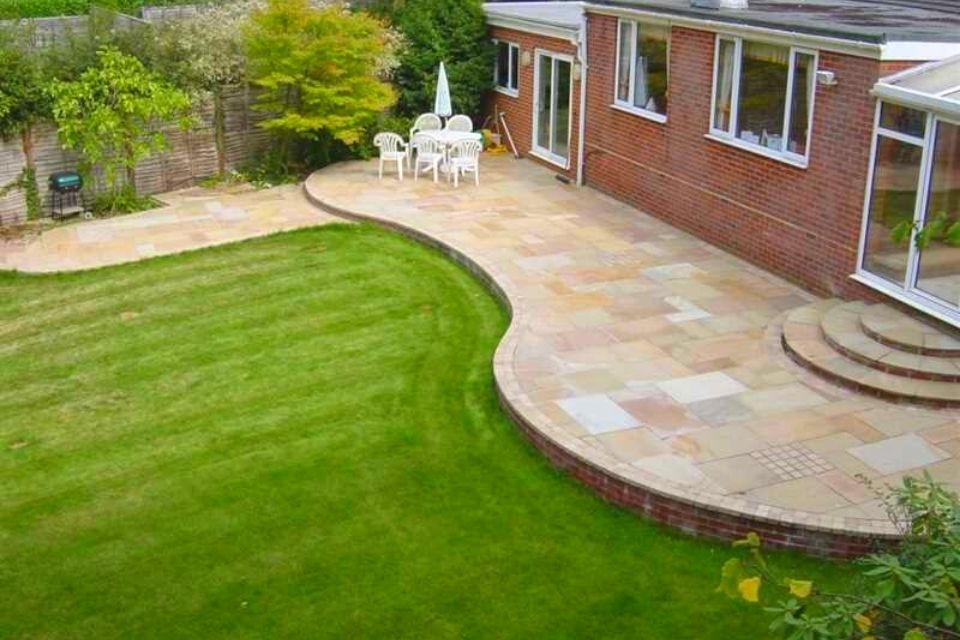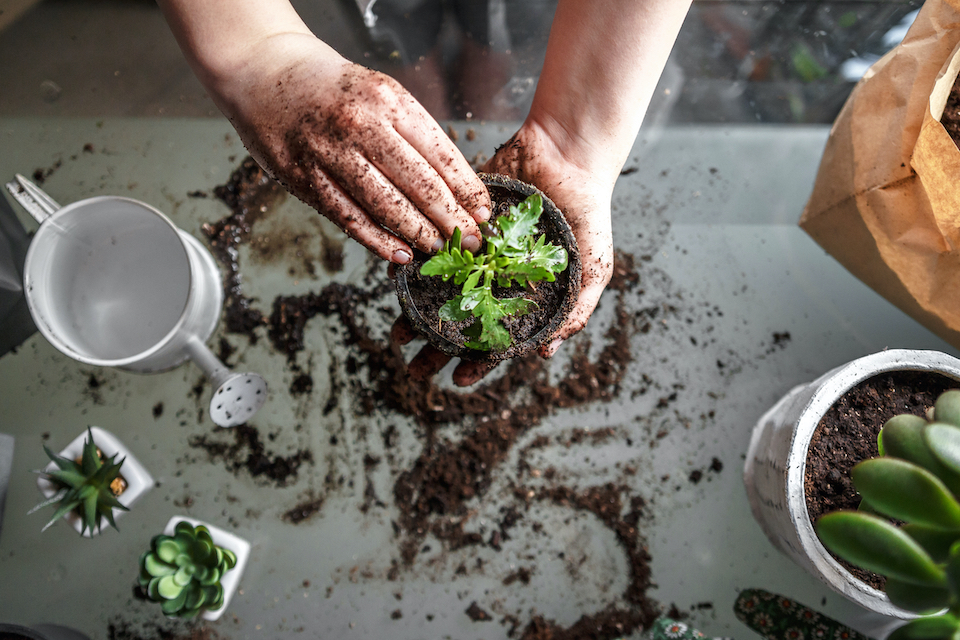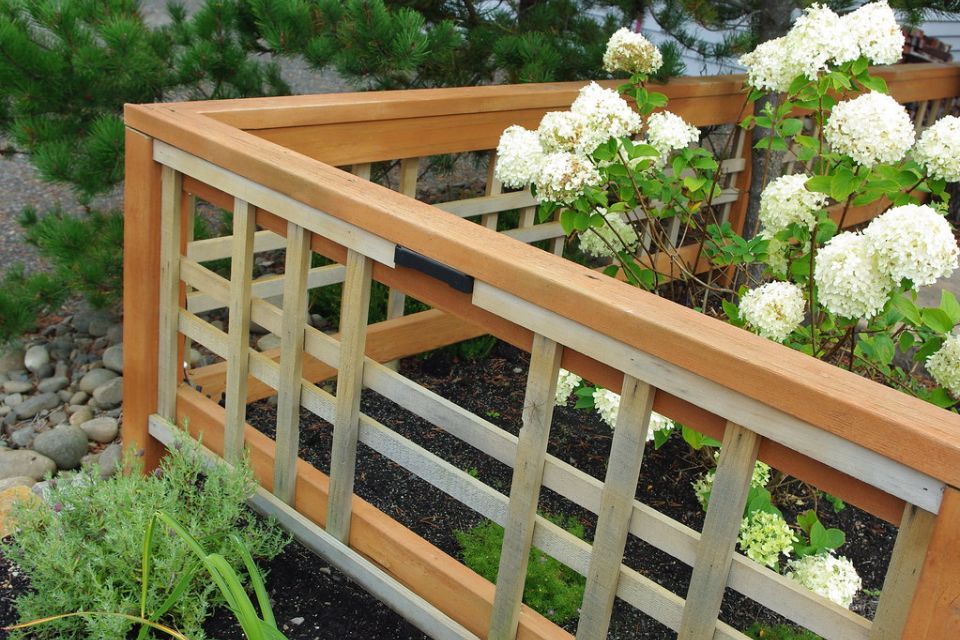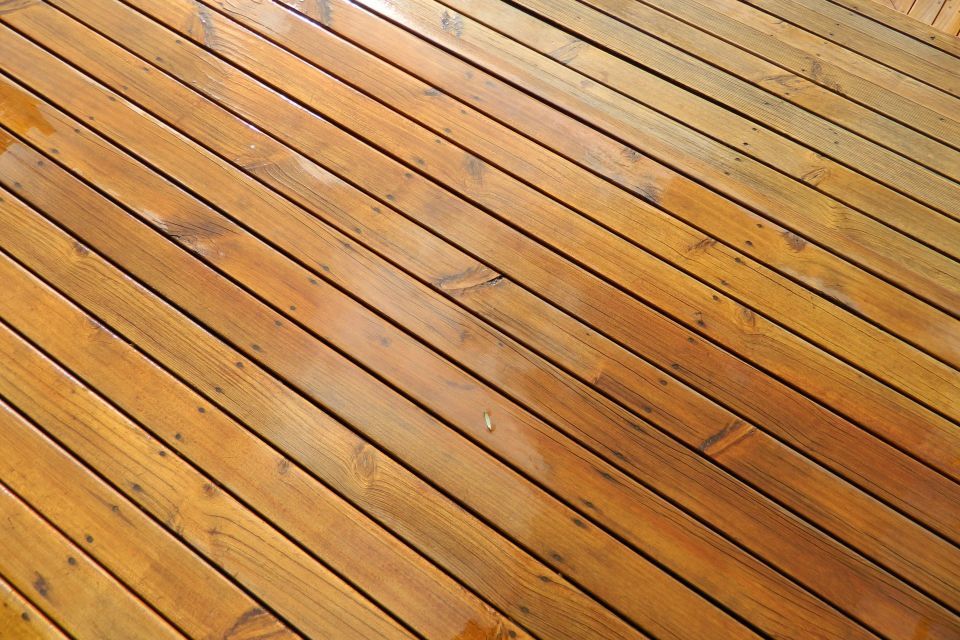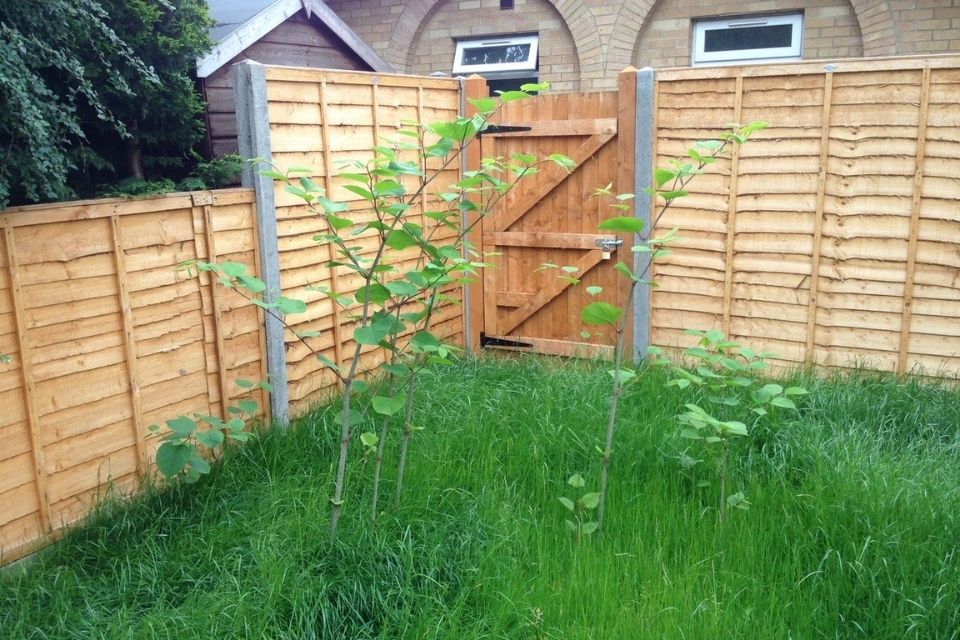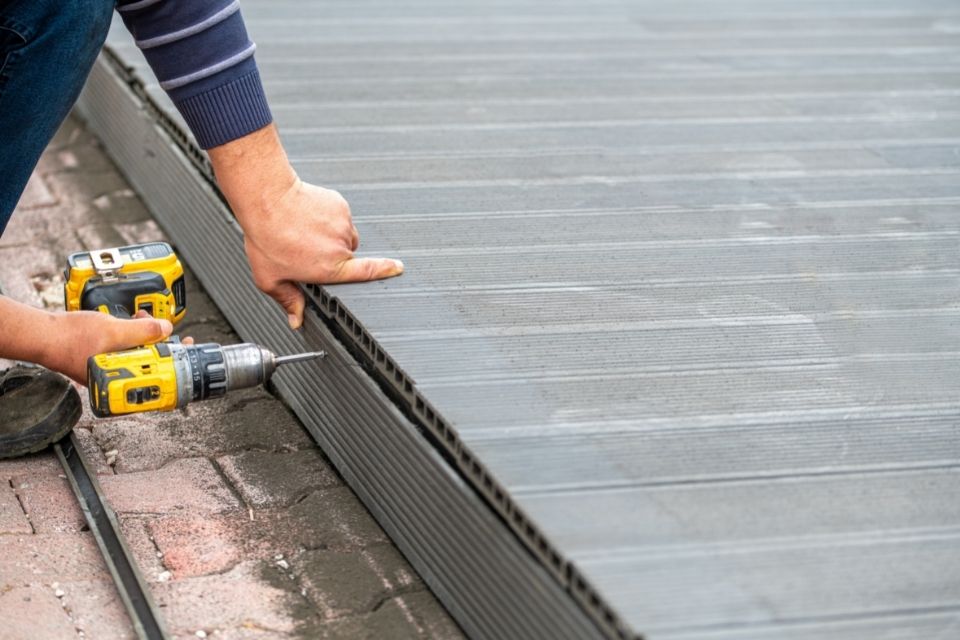How Much to Lay a Patio?
If you want to enhance the look of your property’s exterior, you may want to consider installing a patio.
But how much with patio installation cost?
The average cost of laying a patio will vary depending on the material you choose, for example, the cost of a patio with concrete ranges from £2,500 to £3,000, while clay bricks cost around £2,000 to £2,500.
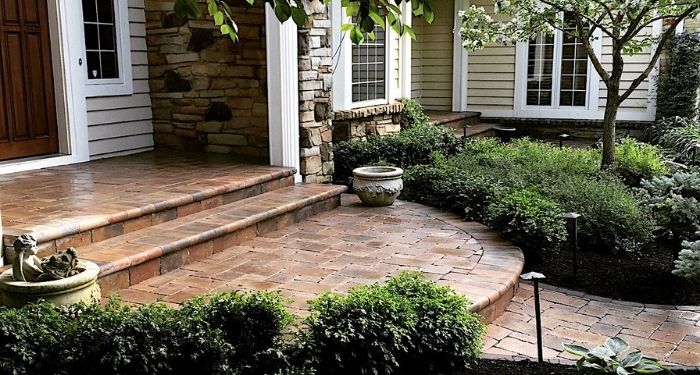
Other patio cost examples include gravel which is normally priced at £1,500 to £2,000, flagstone for £1,300 to £1,900, and £1,500 to £2,900 for a tile patio.
Resin patios range from £1,600 to £2,900 and £1,400 to £5,500 for a paver patio cost.
Patio Laying Prices
| Patio Material | Laying cost per m² |
|---|---|
| Gravel | £35 - £50 |
| Concrete | £55 - £85 |
| Clay bricks | £75 - £100 |
| Flagstone | £45 - £200 |
| Tile | £40 - £75 |
| Pavers | £30 - £150 |
| Resin | £25 - £50 |
- How Much to Lay a Patio?
- What are the Supply Costs of Patio Laying?
- What are the Additional Costs of Patio Laying?
- Tradesmen Costs for Patio Laying
- How Long Does It Take to Lay a Patio?
- Choosing a Patio
- How Much Does It Cost for Patio Maintenance?
- How Much Does It Cost for Patio Repair?
- How Much Does It Cost for Patio Removal?
- Decking As A Patio Alternative
- FAQs
What are the Supply Costs of Patio Laying?
If you plan to lay your own patio, you need to consider the following supply costs for the best price patio slabs.
| Patio Material | Supply cost per m² |
|---|---|
| Gravel | £30 - £45 |
| Concrete | £50 - £80 |
| Clay bricks | £70 - £95 |
| Flagstone | £40 - £195 |
| Tile | £35 - £70 |
| Pavers | £25 - £145 |
| Resin | £20 - £45 |
The type of patio material you choose can significantly influence the overall cost.
What are the Additional Costs of Patio Laying?
There are various other elements to consider when calculating the cost of new patio installation, including:
Concrete Edging
When laying a new patio, you may also want to consider concrete edging. Edging can not only define the patio area further, but it can also support the paving and prevent it from moving or spreading over time.
Concrete edging should be installed before laying the patio slabs if it’s acting as a boundary frame. However, if it’s purely for containment, you can install it after the main patio has been laid and levelled.
The cost of buying edging ranges between £4–£30 per m², depending on the type of material chosen.
Patio Furniture
Once your patio is built, you may want to decorate it with new patio furniture. The cost of patio furniture normally ranges from £90 to £2,300 for a garden dining, while a garden sofa typically costs around £200 to £3,000.
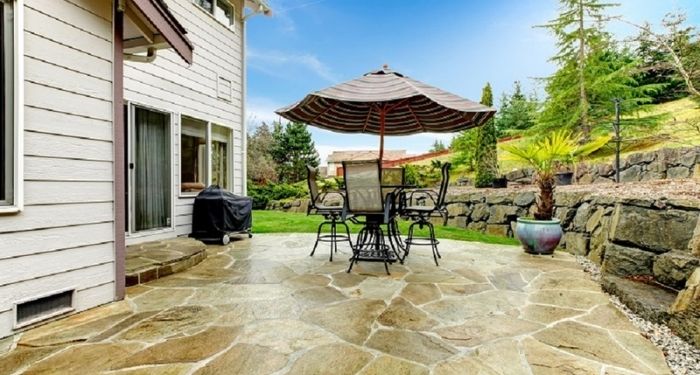
Outside Lighting
To enhance the look of your property and improve security, you should consider installing outdoor lighting. The cost of exterior lights ranges from £4 to £1,000 for wall lanterns, while pathway lights can be purchased for around £2 to £500.
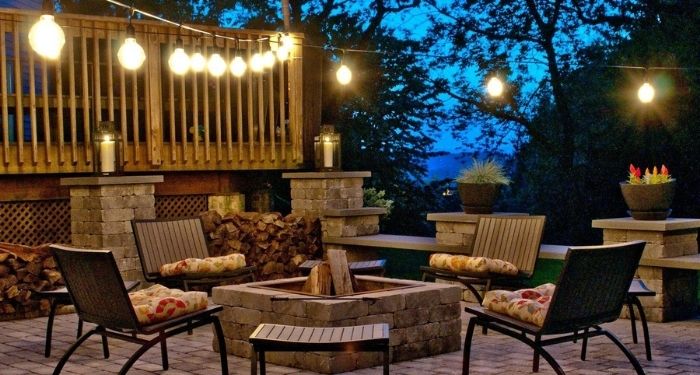
You can opt to install outdoor light yourself or hire an electrician who will charge around £120 to £200.
Outside Heating
If installing an outdoor seating area, then you may also want to consider having outdoor heating fitted.
The average cost out of external heating ranges from £30 to £500 for a patio heater and £50 to £700 for a chimenea.
Patio Doors
For easier access to your patio, you may also want to install new patio doors. The cost of installing patio doors may range from £890 for uPVC French doors, £1,350 for sliding doors, and up to £1,650 for bi-folding doors.
Tradesmen Costs for Patio Laying
Another important patio laying cost you need to consider is the price of labour. Patio installers usually charge around £100 to £200 a day or £75 to £100 per square metre.
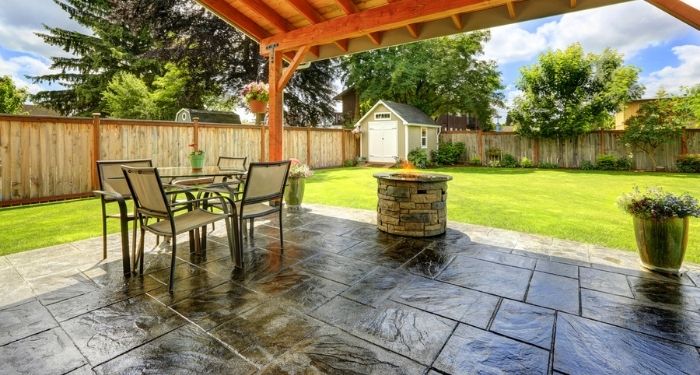
The average labour cost for installing a 5 square metre patio is around £700 to £800, £900 to £1000 for a 20-square metre patio and £1000 to £1200 for a 35-square metre patio.
How to Obtain Accurate Quotes?
When you request quotes from local patio installers, you need to ensure you have several things correct, such as:
- Make sure you know the correct size of your patio. This can be done by measuring the length and width of the patio and multiplying the two figures together. This will give you the size in square metres.
- You need to have an idea of the type of paving you would like. This is essential as it can affect the cost, materials and possibly the labour fees.
- Tell the patio installer if there’s anything specific you would like. Such as raised beds, drainage, pagodas, walls or anything unique to you.
As ever, we advise you to obtain at least three quotes and compare them. You can use our free estimator to help you with this, so you don't have to go chasing numerous tradespeople. Let us do the work for you!
How Long Does It Take to Lay a Patio?
The time required to lay a patio varies based on several factors, including the patio's size, the materials used, site conditions, and whether the work is done professionally or as a DIY project. While smaller patios can often be completed in a couple of days, larger or more complex installations may take a week or more.
Estimated Timeframes for Laying a Patio
| Patio Size | Estimated Duration | Notes |
|---|---|---|
| 5 m² (Small) | 2 days | Suitable for small garden seating areas. |
| 10 m² | 2–3 days | Common size for modest-sized patios. |
| 20 m² | 3–4 days | Ideal for medium-sized outdoor spaces. |
| 35 m² | 4–5 days | Larger patios may require additional time. |
| 50 m² (Large) | 5–7 days | May extend up to 9 days depending on complexity and manpower. |
Factors Influencing Installation Time
- Material Type: Different materials have varying installation complexities. For instance, laying porcelain tiles may take longer than laying concrete slabs due to the need for precise cutting and handling.
- Site Preparation: Tasks such as excavation, base preparation, and ensuring proper drainage can add to the overall timeframe, especially if the ground conditions are challenging.
- Weather Conditions: Adverse weather, particularly rain, can delay the project by making the ground unsuitable for work or by affecting the curing time of materials.
- Access to Site: Limited access can slow down the transportation of materials and equipment, thereby extending the project's duration.
- Labour Force: The number of workers and their experience level can significantly impact the speed of installation.
It's essential to speak to a professional patio fitter to understand the timings for your specific project.
Choosing a Patio
There are several patio types to choose from, which vary in price and also offer various advantages and disadvantages.
To help you decide, here is a breakdown of the different patios and the cost to lay patio paving slabs.
Raised Patio Cost
Raised patios can be an aesthetically pleasing addition to your garden. The patio is raised using a retaining wall, which is then backfilled with aggregate, levelled with sand, and finally, the patio slabs of your choice are laid on top. Raised patios range in price from £80 - £300 per m².
Raised patios can enhance your garden by adding an elevated experience, this also works well in sloped gardens. They are also available in a wide variety of designs and plans.
A raised patio can cost more than other types of patio due to its construction, so this should be considered. Due to the extra materials required, this is also perhaps less accessible to complete on a DIY basis due to the complexity.
Pros:
- Works well in a raised garden
- Gives your garden an elevated dimension to an otherwise flat garden
- Allows you a better view of your garden
- Comes in numerous plans and designs
Cons:
- Involves much more work as it’s more complex
- It may not be achievable as a DIY project
- Potentially more expensive than other types of patio
Indian Stone Patio Cost
Indian stone can give your patio a rustic feel with its natural beauty. It is durable, highly functional and low maintenance once laid. Which makes it perfect for patios. You can arrange your slabs in many designs to ensure you have your very own unique patio. Indian stone patios can cost between £100-£150 per m².
However, Indian stone can be prone to some staining and therefore may need to be sealed, which is a further step in the construction process. It also fares best with professional installation over DIY due to the nature of the stone. Another thing to consider is the price. Indian stone can be costly, therefore putting the entire cost of your patio up.
Pros:
- Aesthetically pleasing with rustic looks
- Durable
- Low maintenance once installed correctly
Cons:
- It’s prone to staining
- Not always a DIY job
- The stone can be expensive
Porcelain Patio Cost
Porcelain paving has been growing in popularity over the years. It gives you a beautiful finish and looks fantastic once laid. It is low maintenance once laid, durable, slip-resistant and frost-proof. This is to name just a few of porcelain's top qualities. You can expect to pay between £100-£200 per m².
Now, on the other side of things, porcelain can be difficult to lay, harder to cut and harder to drill through as they require specialist tools. This makes it less likely to be laid as a DIY job. Porcelain is also more expensive and at the upper end of the patio prices.
Pros:
- Aesthetically pleasing
- Low maintenance
- Durable
- Slip-resistant
- Frostproof
Cons:
- Can be difficult to lay
- Porcelain is harder to cut and drill
- Would benefit by being laid by a professional
- Can be expensive
Gravel Patio Cost
Gravel patios are usually made up of pea gravel which is a smooth material that is normally used for walkways. The average cost of a gravel patio normally ranges from £1,500 to £2,000.
The main benefit of a gravel patio is that it is one of the most affordable materials, which is why it is ideal for large patios and homeowners on a budget.
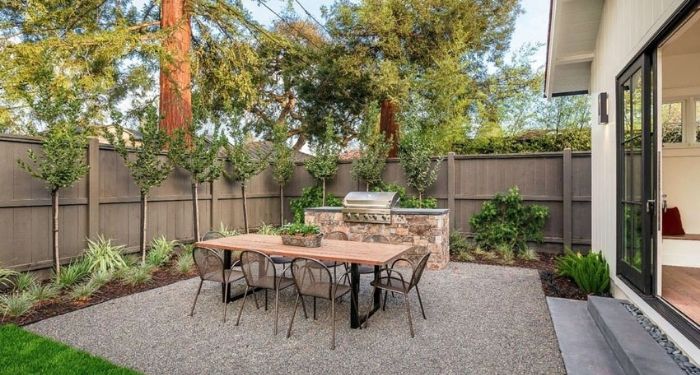
It is also a gardener’s go-to material due to its heat and moisture-resistance. It also offers a multitude of design options due to the wide selection of aggregates available.
One of the downsides of gravel patios is that they are prone to displacement, so they are not ideal for high-traffic gardens.
They are also not the best option for homeowners with children, as there is the risk of a choking hazard, while also not being the best option for underfoot comfort.
Pros:
- Affordable therefore great for a tight budget
- Available in a wide selection of options
- Heat and moisture resistant
Cons:
- Prone to displacement
- Can be dangerous to children or dogs due to them being a choking hazard
Concrete Patio Cost
Concrete patios are constructed by pouring concrete onto level ground. They tend to range from £2,500 to £3,000, and while they may seem expensive, the cost is worthwhile due to concrete’s extensive durability.
It is also one of the easiest materials to install, so you may end up paying less for labour.
One of the main problems with concrete is that it is susceptible to cracking and once damaged it can be very difficult to repair.
It is also not the safest option, as concrete can be slippery when wet, however, this will depend on the type of aggregate you choose.
Pros:
- Durable
- Easy to install in terms of labour costs
Cons:
- Can be more expensive than other options
- Susceptible to cracking and can be difficult to repair
Complex designs and high-end materials can increase costs due to extra labour and precision required.
Clay Brick Patio Cost
Clay bricks are a red-coloured material which can be used for patio installation which costs around £2,000 to £2,500. This type of patio is one of the most durable options as clay bricks can actually last up to 100 years.
They are also highly resistant to fire and are also able to absorb heat easily.
If clay brick patios are left unsealed, they can start to peel away, especially if they are painted. They are also much more susceptible to cracking than concrete pavers and repairs can be expensive.
Pros:
- Highly durable
- Aesthetically pleasing
Cons:
- Can be more expensive than other options
- Susceptible to cracking and can be difficult to repair
- If left unsealed the bricks can be prone to damage
Flagstone Patio Cost
Flagstone is a type of sedimentary rock that is a popular material used for patios and tends to cost around £1,300 to £1,900.
This type of material is extremely durable when looked after properly and flagstone is also very easy to maintain.
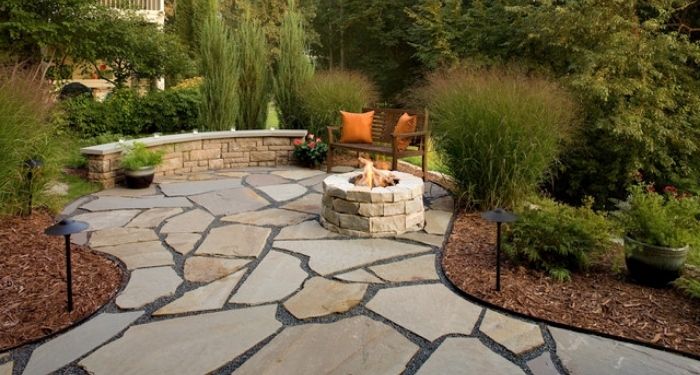
The problem with a flagstone patio is that it can be quite hard to install, so you may end up paying more in labour costs. Similar to concrete, it can be very slippery and it also does not withstand heat very well.
Pros:
- Durable
- Aesthetically pleasing
- Easy to maintain
Cons:
- It can be more expensive than other options
- It can be difficult to install
Tile Patio Cost
A tile patio usually costs around £1,500 to £2,900, although this will depend on the type of tile you choose.
If installing porcelain tiles for your patio, then you can benefit from high-quality weatherproofing, which will prevent moisture damage.
Tile patios are also aesthetically pleasing and there is a wide range of designs to choose from.
A downside of choosing a tile patio is that it can be difficult to install, so cutting and fitting porcelain will require a professionals help.
They also do not offer a natural look that stone or brick offers, which is not attractive to some homeowners.
Pros:
- Durable
- Aesthetically pleasing
- There's a wide range of styles available
Cons:
- It can be more expensive than other options
- It can be difficult to install
Paver Patio Cost
Patio pavers are decorative style materials which are usually made up of brick or concrete and cost around £1,400 to £5,500.
They are one of the most long-lasting and durable patio materials, as they are resistant to harsh weather conditions.
Pavers are also easy to clean, as they only need to be swept a few times a week and sealed once a year.
The problem with pavers is that they tend to be susceptible to weed growth, so you may need to perform weed maintenance regularly.
They also take much longer to install than traditional concrete patios, so you may pay more for labour.
Pros:
- Durable
- Affordable
- There's a wide range of styles available
- Easy to clean and maintain
Cons:
- Susceptible to weed growth
- They can take longer to install
Resin Patio Cost
Resin is a mixture of aggregate and resin which is a popular option for patios and costs around £1,600 to £2,900.
The main benefit of resin paving is that it is one of the most aesthetically pleasing materials with various options. Resin patios are also very easy to install, so it enables you to keep labour costs down.
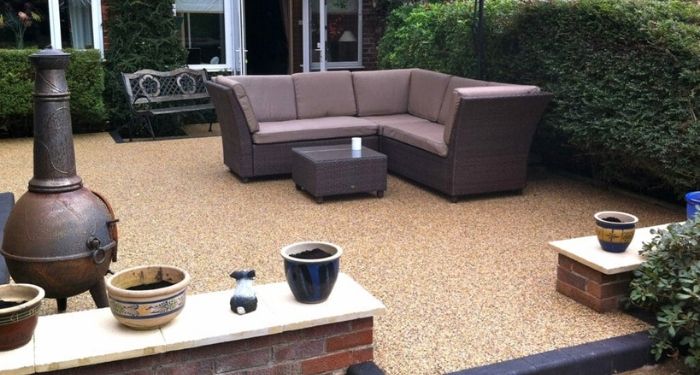
Resin patios are susceptible to moss and weed growth, so it will require a significant amount of maintenance. It is also prone to UV damage, so you may have to pay extra for UV-proof resin.
Pros:
- Aesthetically pleasing
- Easy to install
- There's a wide aggregates available
Cons:
- Susceptible to weed growth
- They can be prone to UV damage
How Much Does It Cost for Patio Maintenance?
To ensure your patio is long-lasting, you should consider the following maintenance costs:
Sealing a Patio Cost
Sealing your patio is an important step in maintaining its appearance and extending its lifespan. A good-quality sealant forms a protective barrier on the surface of the paving, helping to prevent issues such as water penetration, staining, moss growth, and damage from cold weather. It also enhances the colour and finish of natural stone or block paving.
For best results, sealing should be done after a thorough clean and once the patio is completely dry. It’s typically recommended to seal your patio every 2–5 years, depending on the type of material and the amount of wear it receives.
The cost of professional patio sealing ranges from £3 to £7 per square metre. This price usually includes surface preparation, cleaning (sometimes power washing), and the application of the sealant. The overall cost will depend on the size of your patio, the condition of the surface, and whether one or more coats are needed.
While it is possible to seal a patio yourself with products available at most DIY stores, professional sealing ensures an even, long-lasting finish and avoids common DIY pitfalls like streaking or missed patches.
Cleaning a Patio Cost
Another way to protect your patio is by cleaning it regularly. Regular cleaning will keep your patio looking its best and to prevent long-term damage caused by moss, algae, dirt, and weathering. A clean patio not only enhances your garden’s appearance but can also improve its safety by reducing slippery surfaces.
The most effective way to clean a patio is with a professional power wash. This method uses high-pressure water to remove deep-seated grime, stains, moss, and algae from the surface of paving slabs, concrete, or stone.
The cost of professional patio cleaning typically ranges from £150 to £200 for a small patio (up to around 20 square metres), and can go up to £300 to £400 or more for larger patios over 40 square metres. The final price will depend on the size of the patio, level of dirt buildup, the surface material, and the accessibility of the area.
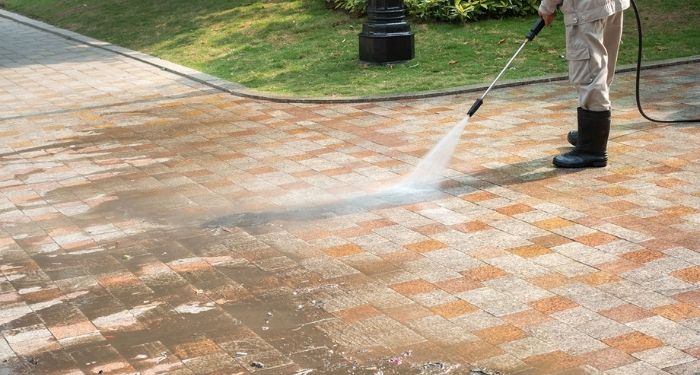
How Much Does It Cost for Patio Repair?
Over time, your patio may start to show small signs of damage which can be repaired. Some of the most common patio repair costs include:
Repointing a Patio Cost
If you have any loose paving bricks or stones, then you may need to have your patio repointed.
This involves clearing out the old pointing and filling the cracks with cement and sand. You can hire a professional to repoint your patio which will cost around £200 to £250.
Patio Crack Repairs Cost
If you have a crack in your patio, you may be able to repair it without having to replace an entire slab. For instance, paving slabs made of concrete or bricks can be filled with epoxy mortars.
You can hire a patio installer to perform a crack repair for around £10 to £20 per square metre.
How Much Does It Cost for Patio Removal?
If you're planning to install a new patio, the first step is often removing the existing one. This process involves:
- Lifting the old slabs
- Clearing the sub-base materials
- Managing the waste removal
All of the elements can add to your overall project budget.
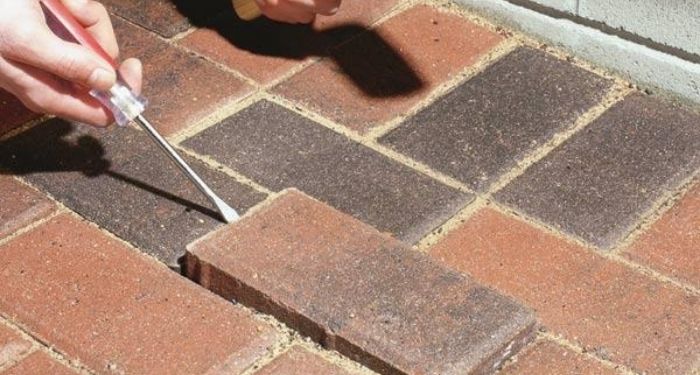
You can hire a professional landscaper garderner or labourer to handle the removal for you. Labour costs typically range from £100 to £200 per day, depending on your location, the size of the patio, and the complexity of the job.
Most standard-sized patios can be removed in 1–2 days, but larger or more heavily constructed patios may take longer.
In addition to labour, you'll need to factor in the cost of waste disposal. Patio materials such as slabs, rubble, and concrete will need to be removed from site. The most common solution is hiring a skip, which generally costs between £60 and £400 depending on the size and duration of hire.
Some contractors may include disposal in their quote, so it's worth checking this in advance.
For a typical 20-square metre patio, total removal costs—including labour and waste—can range from £200 to £500. This is a necessary but often overlooked part of planning a new patio installation.
Decking As A Patio Alternative
When you are looking to expand your outdoor living space laying a patio is just one option. Another popular choice is installing decking.
Both off attractive, functional solutions, but they differ in materials, installation, maintenance, and cost. Choosing which one is right for you depends on your budget, garden layout, and how you plan to use the space.
Patios are long-lasting, low-maintenance, and excellent for permanent outdoor living areas. They are also durable and less likely to suffer from weather-related wear. However, installation can involve extensive excavation and groundwork, especially if drainage or levelling is required.
Decking, on the other hand, is ideal for sloped or uneven gardens and can be faster and less invasive to install. Decking can have a warmer, natural look and is often chosen over patios for lounging or entertaining areas. Timber decking, however does requires regular maintenance like sealing or staining to prevent rot.
Let's compare the two to see if a new patio or new decking is the right choice for your garden.
| Feature | Patio | Decking |
|---|---|---|
| Material | Concrete, stone, paving slabs | Timber or composite boards |
| Best For | Flat, solid ground | Uneven or sloped ground |
| Installation | More groundwork required | Quicker to install, minimal digging |
| Maintenance | Low – occasional cleaning | Moderate – regular sealing/staining (unless composite) |
| Durability | Very durable and weather-resistant | Can be prone to rot unless maintained |
| Cost | £1500–£5500 (depending on size/material) | £925-£3400 (depending on size/material) |
| Aesthetic | Solid, formal appearance | Warm, natural look |
FAQs
Q: What is a patio?
A: A patio is a paving area which is connected to the exterior of a property. It is normally utilised in gardens to accommodate a seating area.
Q: Which patio cleaner is the best?
A: There are various products available that are useful for cleaning patios, although the best options include weed and algae killing solutions, mild detergents, and non-acidic sprays.
Using these products will enable you to clean your patio without damaging the surface.
Q: What is a good slope for a patio?
A: To meet building regulations, patios must slope away from the house at an angle of least 3mm.
Q: What kind of paint do you use on a cement patio?
A: To spruce up your patio, you could consider re-painting it with concrete paint. However, before doing so you should make sure that the patio is clear of any dirt, dust and moss, and any cracks are filled.
Q: Will a patio increase home value?
A: Having a new patio installed can actually add up to £10,000 to the value of your home, and you can actually recoup up to 85% of the patio installation cost.

